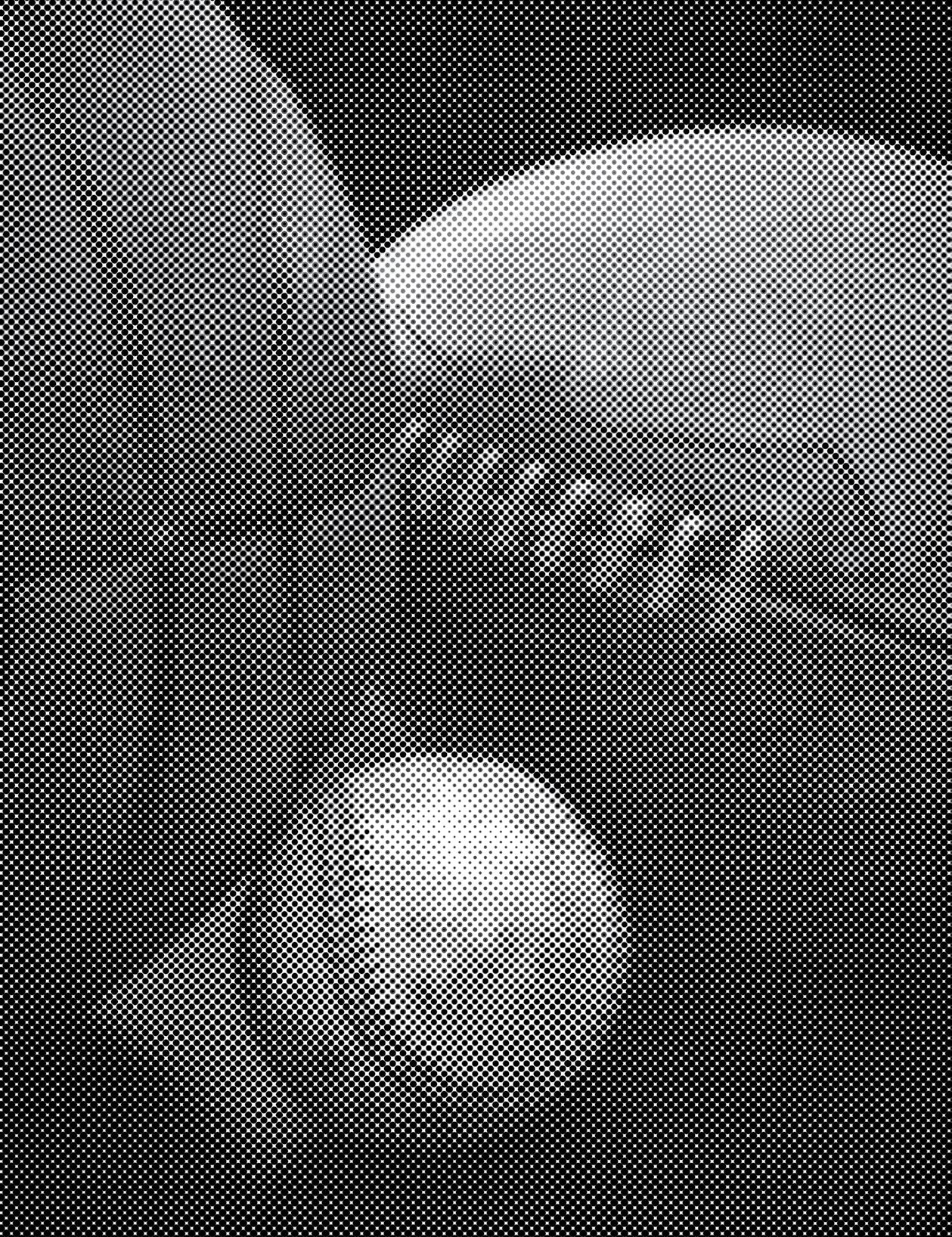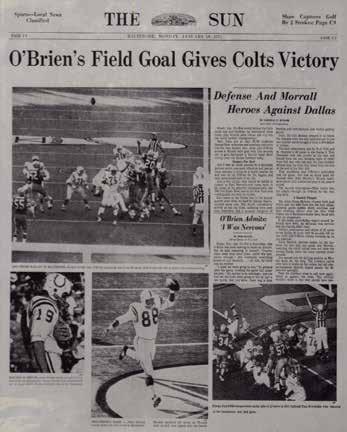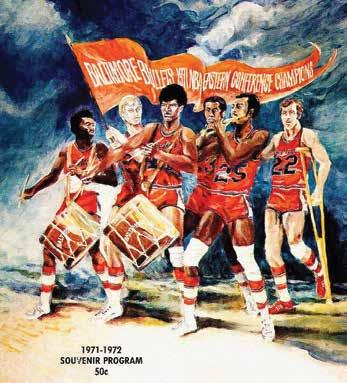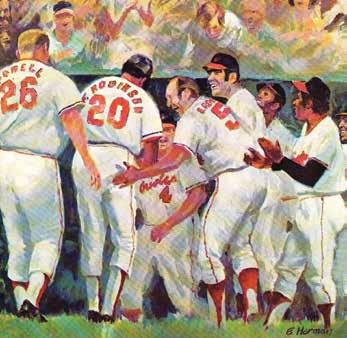
10 minute read
When Charm City
WHEN CHARM CITY WAS PRO SPORTS CENTRAL
Fifty years ago, Baltimore’s teams were among the best in the NFL, NBA, and MLB. Not all came out on top, but near-best seemed pretty good—and exciting—at the time
BY FREDERICK SCHULTZ
or fans following Baltimore pro sports over the past half-century, it’s been quite a roller-coaster ride, with favorite teams being either champs or chumps. But we stuck with them. This is all notwithstanding the real clinker over that time span, when the Colts’ owner, the late Bob Irsay, clandestinely moved the team in 1984 to Indianapolis in the dead of night. Happily, anyone who’s spent a childhood worshipping the city’s sports legends will have vivid memories come rushing back when revisiting 1971, exactly fifty yesteryears ago. So, let the old newsreel begin.
The Sixties had been wild enough, but to say the early Seventies was an odd era would be an understatement. The Vietnam War was still smoldering, and President Richard Nixon was still in his first term. Men’s fashion turned to cheesy leisure suits, mutton-chop sideburns, gaudy plaid “flaired” dress pants, and matching sport coats, wide ties (for those who wore them), “baggy” casual pants, hideous platform shoes, and all polyester, all the time. For women, miniskirts of the Sixties had given way to maxi- and midi-, as hotpants simultaneously seared their way onto the scene.
Hairstyles had gone “shag” for both sexes, especially after a shagged Jane Fonda appeared in the 1971 motion picture Klute, and the newly-solo Beatle Paul McCartney sported a similar ’do. And men’s pro sports teams followed suit, assimilating longer hairstyles, beard and moustache growth, and “double-knit” synthetic-fabric uniforms.
Women’s professional sports hadn’t yet taken hold, but this was the year the five-player, full-court game and a 30-second shot clock was introduced to amateur women’s basketball—a baby-step, but a step nonetheless.
See You at “The Stadium”
Baltimore’s football and baseball home was the old Memorial Stadium, between East 33rd and East 36th streets, which lived up to its reputation for Colts games as “the world’s largest outdoor insane asylum.” We could devote an entire article on its various iterations, but the foundation structure was built in 1922, and the stadium as current old-timers knew it closed in 1997. Fall schedules of the Colts and the Orioles often overlapped, with one football endzone in the baseball infield, and the baseball outfield lined off with the stripes of a football gridiron.
Unlike the custom venues for each sport today, M&T Bank Stadium and Oriole Park at Camden Yards, Memorial Stadium was at one time the city’s only pro home turf. What’s more, it was also not all that friendly to fans. The seats were wooden, and not “contoured,” if you get the drift. And if you decided to go to a baseball game after work on a weeknight, tickets were usually available. But you had to beware of the guy at the ticket-sales booth who would say, “I’ll tell you what I’m going to do for you,” then sell you “lower-reserve” seats that were behind a support column for the upper deck and thus blocked your view of the field.
The Baltimore Sun newspaper carried headlines on the C1 page of the Baltimore Colts Super Bowl V win on Monday, January 18, 1971.

In 1971, it had been just two years since both the Orioles and the Colts swallowed the bitter pill of defeat in 1969 at the hands of two brash clubs from New York. The National League champs that would be christened the “Miracle” Mets teamed “Tom Terrific” Seaver with underrated pitching star Jerry Koosman to pick apart the Birds’ power lineup. And a cocky playboy Jets quarterback named “Broadway” Joe Namath (once best known for donning women’s pantyhose in a 1973 Hanes Beautymist commercial and now a TV pitchman for supplemental Medicare insurance) made good on his pregame victory predictions. The Colts, Bullets, and Orioles extravaganza that unfolded in 1971 wasn’t always pretty. But the year was arguably the city’s pro-sports best.

Super Bowl-Bound
The Colts won both of their 1970 playoff games in Memorial Stadium, breezing through the AFC East divisional game 17-0 against the Cincinnati Bengals and the AFC championship 27-17 over the Oakland Raiders. The Head Coach was Don McCafferty, and their legendary quarterback was John Unitas. (Players rarely, if ever, called him “Johnny,” according to this reporter’s 2008 conversations with now-deceased former Colts Ordell Braase, Art Donovan, and Jim Mutscheller, appearing at a program at the Maryland Historical Society celebrating “The Greatest Game Ever Played,” which is a story for another time. “That (‘Johnny’) was a media invention,” they agreed.)
Ironically, one of the best extant rundowns of the Colts-Cowboys Super Bowl V matchup in ’71 comes from Mark Morthier, an avowed lifelong Dallas fan. In “Super Bowl V: The One I’ll Never Forget,” an online article written for “The Sports Column,” he recounts all the messy details of the game that became forever known as “The Blunder Bowl,” with those words plastered across the cover of the next issue of Sports Illustrated.
On January 17 at the Orange Bowl in Miami, it was the first Super Bowl ever played on artificial “PolyTurf” and the only one to have a player from the losing team and a non-quarterback, Cowboys linebacker Chuck Howley, named the game’s Most Valuable Player. After a total 11 turnovers, 14 penalties, a blocked pass, a blocked extra-point kick, and an injury that knocked starting quarterback Unitas out of the game, the deciding play fell on rookie Colts’ kicker Jim O’Brien, who split the uprights A program from the January 17, 1971 with a 32-yard field Super Bowl V played at the Orange goal to win the game
Bowl in Miami between the Balti16-13 with five seconds more Colts and the Dallas Cowboys. left on the clock. A souvenir program from the 1971 Baltimore Bullets NBA Finals home game announces the team as the Eastern Conference Champions on the cover.
“I wasn’t the greatest kicker and I never pretended to be,” O’Brien was quoted as saying by reporter Jorge Milian in a January 2010 story in the Palm Beach Post. “I never told anybody I was. But whenever we needed a kick [except, of course, that blocked extra point, which made the field goal necessary for the win], I made it.”
Bullets Go to the NBA Finals
The Baltimore Bullets (with the Civic Center—now Royal Farms Arena—as their home court) had star guard Earl “the Pearl” Monroe, forward Gus Johnson, and a powerful young center named Wes Unseld for the 1970–71 season, each of the three future NBA Hall-of-Famers. The Bullets went all the way to the NBA finals in 1971, losing against the Milwaukee Bucks and their star rookie center named Lew Alcindor, who changed his name, just after the Bucks won the championship game, to Kareem Abdul-Jabbar. The journey to the final was what captured the attention of Baltimore fans, however. The Bullets’ four-games-to-three win over the rival (some sportswriters said “hated,” which was probably more accurate) New York Knicks in the Eastern Finals helped ease the pain felt after losing to the Bucks for the title.
While the Bullets’ stars of the series had been mostly Unseld and Monroe, the seventh-game savior was Monroe’s roommate, second-year guard Fred Carter, a relative unknown from Mount Saint Mary’s College (now University) outside Emmitsburg, Maryland, where his jersey and number have been retired. With 68 seconds left in the game, Carter scored, according to the Baltimore Sun, “the biggest basket in Baltimore Bullets history,” beating the Knicks as Unseld batted away their last-gasp shot before the final buzzer.
Orioles’ Baseball
After having won the 1970 World Series against the star-studded Cincinnati Reds’ “Big Red Machine,” Baltimore’s Orioles were becoming a dynasty, or so some thought. In ’71, the team had four 20-game-winning pitchers: Jim Palmer, Dave McNally, Miguel (“Mike”) Cuellar, and Pat Dobson. But the Pittsburgh Pirates had other thoughts for Major League Baseball’s 68th “fall classic.”
It was against the Reds that Brooks Robinson had earned the nickname “Human Vacuum Cleaner” for his defensive acrobatics at third base. And Brooks’ bat, along with those of Frank Robinson and Boog Powell, and Merv Rettenmund, who had the third-best batting average in the league, were formidable forces going into this series after the O’s had beaten the Oakland Athletics in three straight for the league title. But the Pirates, who had won their league championship series three games to one over the San Francisco Giants, had their powerhouse hitters Willie Stargell and Roberto Clemente (the first Spanish-speaking player to be named the series’ Most Valuable Player) to help make it a nearly even match-up.
Less likely heroes such as third baseman Richie Hebner (who tagged Orioles ace Jim Palmer with a three-run homer in Game Two) and unscheduled Game Five starter Nelson Briles, who pitched a two-hit shutout to save a fresh starter for Game Seven (a brilliant move by Manager Danny Murtaugh), helped dash the Birds’ hopes for repeating as Series champs.
As fans are wont to say, “Just wait till next year!” But “next year” turned out to be 1979, when the Pirates encored, beating the Orioles again, four games to three.
Baltimore Radio and TV announcer Chuck Thompson, himself inducted into the Baseball Hall of Fame in 1993, had belted out his celebratory exclamations “Ain’t the beer cold!” and “Go to war, Miss Agnes!” a lot in ’71. But that’s now but a cherished memory, 50 years hence. And nobody but Chuck knew who “Miss Agnes” really was.
A collectible postcard distributed by Baltimore company D.E. Traub depicts Memorial Stadium, where both the Colts and Orioles played home games for several decades.
An Orioles home game program from the 1971 World Series.
Epilogue


When this story assignment came along, Editor James Houck wondered whether I might be interested. A life-long fan of Baltimore sports, I jumped at the chance. As a kid, I was Brooks Robinson, played third base, and wore his number 5. My Dad’s friend Paul called on Mother’s Day morning in 1966 and had two tickets to go with the two he had for an Orioles double-header against the Cleveland Indians. Since it was Mother’s Day, Paul said, “See what kind of sport she is.” My Mom was a great sport, and we had box seats right behind the plate when Frank Robinson came up against Luis Tiant and hit a fastball completely out of Memorial Stadium, the one and only time it’s been done. In fact, from that time until the stadium closed, the point where the ball went over the wall and into the parking lot below was marked with a flag that said, simply, “HERE.”
In keeping with this theme, I was also in the crowd for Game Seven of the 1971 World Series, but the journey there was as much a part of the story as the Orioles’ loss that day as told in this story. A business friend of my Dad’s, a red-haired guy named “Reds” (naturally), was a regional distributor of Royal Crown Cola and Nehi fruit sodas based out of inner-city Baltimore, and he had free tickets to the game. The only trick was, my Dad had to drive downtown to pick them up at Reds’ home warehouse just before the game. This was decades before the fancy downtown stadiums and the Inner Harbor, so we cou- You can almost still hear the old Baltimore rageously journeyed into the Colts Marching Band, what Barry Levinson bowels of Baltimore to retrieve (his must-see classic movie was Diner) referred to as “The Band that Wouldn’t the tickets that Reds had guar- Die,” decked out in their fringed rawhide anteed would be there waiting jackets and cowboy hats, instrumentally for us. Sure enough, they were. belting out the team’s fight song that But the seats were in the right went like this (yes, there were lyrics, too!): field bleachers, about as far Let’s go you Baltimore Colts; And put the ball across the line; So drive on you Baltifrom the field as you could more Colts; Go in and strike like lightning get. And the Birds lost. But bolts; Fight Fight Fight; Rear up you colts we didn’t really care. It was and let’s fight; Crash through and show The World Series! Thanks for them your might; For Baltimore and Maryeverything, Dad! land; We will march onto victory!










